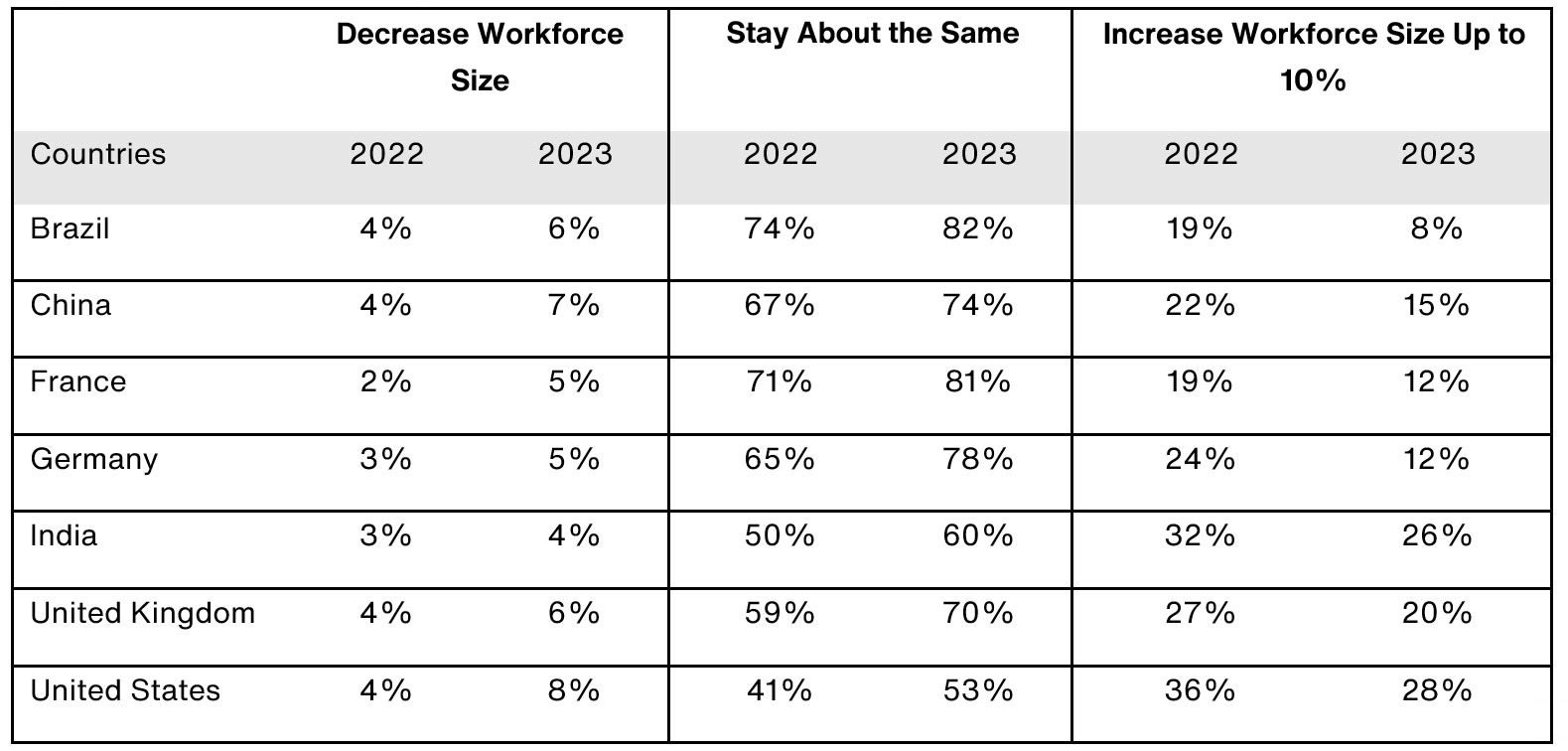How to Balance Cost with Growth in a Shifting Talent Market

To maintain a competitive edge in today’s fast-paced and volatile world, HR leaders must harness the power of their people data.
Key Takeaways
-
Placing too much emphasis on near-term cost pressures could jeopardize an organization’s ability to develop and maintain its critical capabilities.
-
Companies should play defense by rationalizing their workforce, assessing the cost of their employee programs and managing organizational change.
-
Companies can use their people data and analytics to manage their talent — and benchmark their performance against their peers.
Persistent macroeconomic headwinds, coupled with an ongoing war for talent, continue to create a dynamic tension for many companies. On the one hand, leaders must focus on cost-control measures to preserve operating margins and make it through this period of economic uncertainty. On the other, they must also protect the vital capabilities required to deliver their business strategy. By placing too much emphasis on near-term cost pressures, leaders can jeopardize their organization’s foundation for growth. Conversely, by focusing too much on growth, leaders imperil the financial resources required for future investment.
So, how can leaders strike the right balance between maximizing their people spend while also positioning their organizations for sustained growth? There is no simple answer, but an effective approach involves using their people data and analytics to accomplish both priorities. Through people data, HR leaders can unlock unique insights to help navigate near-term uncertainties, while also maintaining course for the future.
Playing Defense: Using Data to Make Informed Decisions to Optimize Spend
Persistent inflation in certain parts of the world has led to tighter financial conditions, as central banks continue to hike interest rates in an effort to maintain stability. The resulting effects include higher operational costs and the need for businesses to conserve cash to preserve operating margins.Labor costs are the biggest operating cost for most organizations. Optimizing people spend is therefore a common business strategy to control this. As a result, companies are revisiting their total rewards programs. In certain cases, some organizations are reducing headcount or slowing down their hiring activity. Global results from our latest Salary Increase and Turnover Study indicate an uptick in companies decreasing their workforce size and a decline in companies planning to grow their workforce compared to 2022.

Expected Workforce Changes in 2022 vs. 2023
Source: Aon’s 2022 Salary Increase and Turnover Study – Second Edition; Aon’s 2023 Salary Increase and Turnover Study – First Edition
“While the near-term effects of these actions will help organizations manage cost, leaders must not lose sight of the longer-term implications of their decisions on productivity, engagement and retention, as well as their employee value proposition,” says Marc Pajarillo, a partner in Aon’s Talent Solutions practice. “When used effectively, an organization’s people data can be a critical tool in this balancing act.”
Before diving into major workforce cuts or changes that may have unintended consequences down the road, consider the following:
- Rationalize your workforce. People data and analytics can be a critical to assessing where firms stand. Companies should benchmark their compensation, health and benefit programs; review job architecture; and explore voluntary separation programs if a headcount reduction is necessary.
- Reduce the costs of employee programs. To mitigate people spend, look at how total rewards can be optimized to ensure delivered benefits and pay are highly valued. Total rewards that are not valued or properly communicated should be reevaluated from a cost, use and employee value proposition perspectives.
- Manage the journey. Firms should ensure changes are executed properly to avoid the risk of disengaged employees. Project management, proper design of new or revised programs, employee communication and change management are all areas that can’t be overlooked. Otherwise, people leaders risk eroding their employee value proposition and creating unintended consequences around employee attraction and retention.
Playing Offense: Future-Proofing Workforce Strategy
Talent scarcity continues to be a major concern for many organizations. In response, companies are increasingly focusing on talent mobility to “build from within,” with 48 percent focusing on improving talent progression and promotion processes to help increase the availability of talent. Other methods to address the talent gap include enhancements to organizations’ total rewards and professional development strategies, with 36 percent offering higher wages and 34 percent investing in reskilling and upskilling programs respectively.
Many employees can be reskilled or upskilled into new roles that their employer needs, but the firm has to first assess who those individuals are and what the future jobs of the organization will be.
Since the COVID-19 pandemic, wellbeing has also become an effective means to attract, retain and sustain workforces — in other words, it is now a critical part of a company’s workforce strategy.
According to Aon’s 2022-2023 Global Wellbeing Survey, there is a positive correlation between wellbeing and an organization’s financial performance. For every 4 percent increase in wellbeing performance, organizations experience a one percent increase in company profit, along with increases in employee satisfaction, customer satisfaction and a decrease in employee turnover.
As overall hiring has slowed, finding talent for in-demand roles remains a challenge. Unemployment in many countries remains low and employees with future-leading hard and soft skills remain in high demand. However, through the use of people data, HR leaders can play an active role in positioning the business for growth in several areas:
- Develop Your Talent Strategy. It’s important to understand the skills of the current workforce and learn more about what employees value to inform strategy going forward. This includes attracting, developing and retaining talent to support a firm’s overall business strategy. Modernize career frameworks and provide the basis for compensation and promotion decisions. Use assessments to make better talent acquisition and development decisions (this data can also help uncover skills among current employees that employers may not have known). And conduct annual pay equity audits to ensure pay is being determined fairly and transparently (see our article New-Hire Salaries are Rising – Along with Concerns About Pay Equity to dive deeper on this topic).
Case Study: Delivering Growth With Assessments and Job Architecture
Here’s an example where job architecture and talent assessments can be brought together for strategic growth. A leading multinational healthcare organization reviews its job architecture and determines it will need to create new a new team of around 20 individuals that will sit within the IT function. These roles will be responsible for evaluating and working with other teams to integrate artificial intelligence with its current health solutions. Having recently conducted talent assessments across its functional departments, this organization knows which employees have scored well with certain digital skills, which employees have expressed a desire to work on cutting-edge technology and which employees have expressed a desire to learn new skills and grow their career. Taking this collective data, the employer can target certain employees for upskilling job opportunities and vet them for a promotion to future roles. These roles will be filled quicker and likely at less cost and resources for the organization than hiring externally.
- Sustain Talent. While HR teams typically spend a great deal of time and effort thinking about retaining talent, sustaining the workforce is equally important. In the aftermath of the COVID-19 pandemic, understanding what people need in order to have a sustainable working life, prevent burnout and help them thrive in their job has become “table stakes.” Tools such as Aon’s Human Sustainability Index measure wellbeing, resilience and sustainability at the individual, team and organizational level. This data allows HR leaders to measure and track how the workforce (collectively and individually) is being sustained over time.
- Monitor and Benchmark Programs. Surveys and other tools are essential to benchmark compensation programs against peers. It’s also important to monitor and mitigate people risk associated with reputation, shareholders, financial stakeholders, and rising environmental, social and governance expectations.
Adapt to Current Conditions and Plan for the Future
Companies have the unique opportunity to reimagine the ways they manage their people-related costs, while also optimizing their workforce. The past three years has taught HR leaders that conditions can change quickly, and they must be proactive and adaptable to change. Current workforce challenges may be different than those experienced months prior. HR leaders should stay on top of trends by using their people data and analytics to manage spend and plan for the future. This will help them make quick decisions about the programs they should review and optimize. At the same time, HR leaders should ensure there are long-term investments in their current workforce. Skills should be evaluated, utilized and incorporated in workforce planning, all while making people feel supported in their career to prevent burnout.
For additional reading on this topic, see our article, How Data and Analytics Can Optimize HR Programs.
General Disclaimer
The information contained herein and the statements expressed are of a general nature and are not intended to address the circumstances of any particular individual or entity. Although we endeavor to provide accurate and timely information and use sources we consider reliable, there can be no guarantee that such information is accurate as of the date it is received or that it will continue to be accurate in the future. No one should act on such information without appropriate professional advice after a thorough examination of the particular situation.
Terms of Use
The contents herein may not be reproduced, reused, reprinted or redistributed without the expressed written consent of Aon, unless otherwise authorized by Aon. To use information contained herein, please write to our team.
70%
Employees who strongly agree that their organization cares about their overall wellbeing are nearly 70% less likely to actively search for a new job, and 71% less likely to report burnout.
Source: Aon’s 2022-2023 Global Wellbeing Survey
Aon's Better Being Podcast
Our Better Being podcast series, hosted by Aon Chief Wellbeing Officer Rachel Fellowes, explores wellbeing strategies and resilience. This season we cover human sustainability, kindness in the workplace, how to measure wellbeing, managing grief and more.
Aon Insights Series Asia
Expert Views on Today's Risk Capital and Human Capital Issues
Aon Insights Series Pacific
Expert Views on Today's Risk Capital and Human Capital Issues
Aon Insights Series UK
Expert Views on Today's Risk Capital and Human Capital Issues
Construction and Infrastructure
The construction industry is under pressure from interconnected risks and notable macroeconomic developments. Learn how your organization can benefit from construction insurance and risk management.
Cyber Labs
Stay in the loop on today's most pressing cyber security matters.
Cyber Resilience
Our Cyber Resilience collection gives you access to Aon’s latest insights on the evolving landscape of cyber threats and risk mitigation measures. Reach out to our experts to discuss how to make the right decisions to strengthen your organization’s cyber resilience.
Employee Wellbeing
Our Employee Wellbeing collection gives you access to the latest insights from Aon's human capital team. You can also reach out to the team at any time for assistance with your employee wellbeing needs.
Environmental, Social and Governance Insights
Explore Aon's latest environmental social and governance (ESG) insights.
Q4 2023 Global Insurance Market Insights
Our Global Insurance Market Insights highlight insurance market trends across pricing, capacity, underwriting, limits, deductibles and coverages.
Regional Results
How do the top risks on business leaders’ minds differ by region and how can these risks be mitigated? Explore the regional results to learn more.
Human Capital Analytics
Our Human Capital Analytics collection gives you access to the latest insights from Aon's human capital team. Contact us to learn how Aon’s analytics capabilities helps organizations make better workforce decisions.
Insights for HR
Explore our hand-picked insights for human resources professionals.
Workforce
Our Workforce Collection provides access to the latest insights from Aon’s Human Capital team on topics ranging from health and benefits, retirement and talent practices. You can reach out to our team at any time to learn how we can help address emerging workforce challenges.
Mergers and Acquisitions
Our Mergers and Acquisitions (M&A) collection gives you access to the latest insights from Aon's thought leaders to help dealmakers make better decisions. Explore our latest insights and reach out to the team at any time for assistance with transaction challenges and opportunities.
Navigating Volatility
How do businesses navigate their way through new forms of volatility and make decisions that protect and grow their organizations?
Parametric Insurance
Our Parametric Insurance Collection provides ways your organization can benefit from this simple, straightforward and fast-paying risk transfer solution. Reach out to learn how we can help you make better decisions to manage your catastrophe exposures and near-term volatility.
Pay Transparency and Equity
Our Pay Transparency and Equity collection gives you access to the latest insights from Aon's human capital team on topics ranging from pay equity to diversity, equity and inclusion. Contact us to learn how we can help your organization address these issues.
Property Risk Management
Forecasters are predicting an extremely active 2024 Atlantic hurricane season. Take measures to build resilience to mitigate risk for hurricane-prone properties.
Technology
Our Technology Collection provides access to the latest insights from Aon's thought leaders on navigating the evolving risks and opportunities of technology. Reach out to the team to learn how we can help you use technology to make better decisions for the future.
Top 10 Global Risks
Trade, technology, weather and workforce stability are the central forces in today’s risk landscape.
Trade
Our Trade Collection gives you access to the latest insights from Aon's thought leaders on navigating the evolving risks and opportunities for international business. Reach out to our team to understand how to make better decisions around macro trends and why they matter to businesses.
Weather
With a changing climate, organizations in all sectors will need to protect their people and physical assets, reduce their carbon footprint, and invest in new solutions to thrive. Our Weather Collection provides you with critical insights to be prepared.
Workforce Resilience
Our Workforce Resilience collection gives you access to the latest insights from Aon's Human Capital team. You can reach out to the team at any time for questions about how we can assess gaps and help build a more resilience workforce.
More Like This
-

Article 6 mins
Leading the Biofuels Transition: Risk Strategies to Cut Through Complexity
Companies aiming to be a net-zero company may face many challenges during the biofuels transition. Read more on risk strategies to cut through complexity.
-

Article 6 mins
DC Pension Schemes: Improving Investment Returns
With DC schemes growing across Europe, many organizations are realizing the importance of ensuring strong performance from their investments. Here’s how asset owners and managers can optimize DC outcomes through the right investment strategy.
-

Article 9 mins
Developing a Paid Leave Strategy That Supports Workers and Their Families
With no federal paid leave law in the U.S., employers have limited guidance in designing equitable and comprehensive paid leave programs to support their workforce. Looking beyond compliance to focus on strategy and values will help create fair and well-designed policies.











































































































































